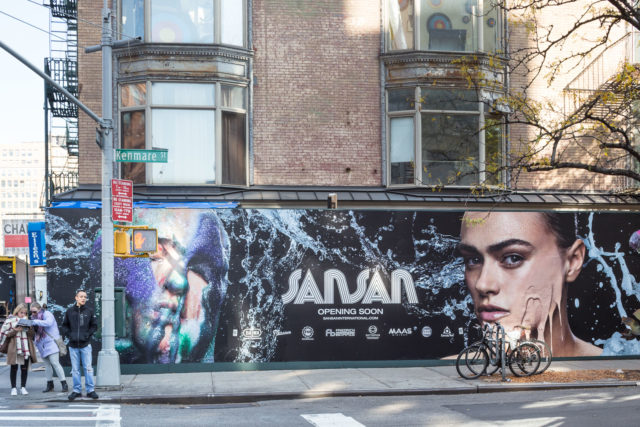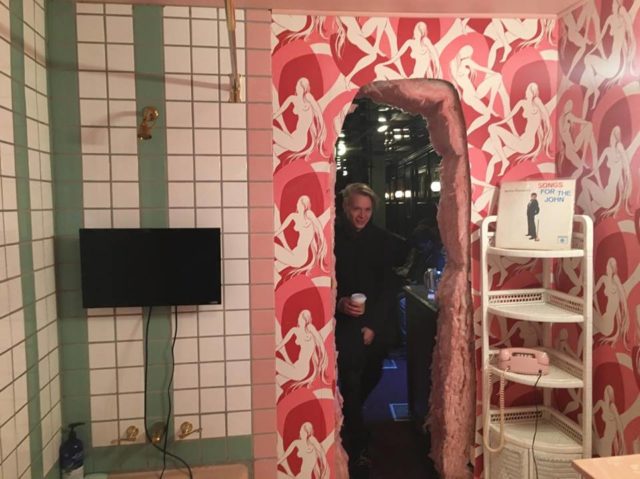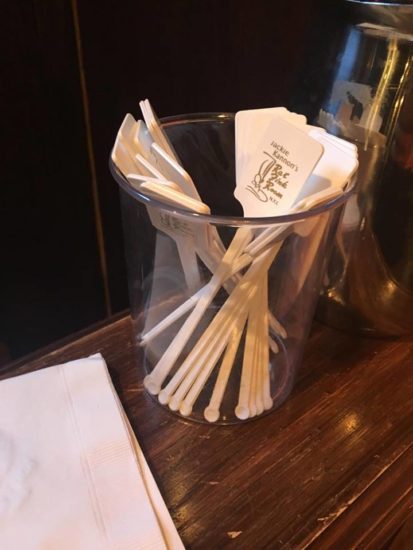
“Paranoia Man in a Rat Fink Room” by Jonah Freeman and Justin Lowe. Commissioned by Storefront for Art and Architecture and the New York Comedy Festival, 2016. Photo by Brett Beyer.
Jonah Freeman and Justin Lowe: Paranoia Man In A Rat Fink Room
Storefront for Art and Architecture
97 Kenmare Street
New York, NY
On view until February 18, 2017
New Yorkers are prone to nostalgia. It’s a byproduct of the city’s rapid changes and frequently traumatic displacements, which is why art addressing these constant evolutions is almost always relevant.
The latest project confronting New York’s transformations is Jonah Freeman and Justin Lowe’s Paranoia Man In A Rat Fink Room at Storefront for Art and Architecture. While gentrification is well-trod artistic territory, the show takes a fresh angle on the subject by representing, at once, the city’s seedy past, transitional present and sleek future. Beyond the city, the installation also indirectly but successfully points out the alternative space’s anachronistic placement within the open-air mall of contemporary SoHo.
Paranoia Man In A Rat Fink Room is a trip into old New York hidden beneath a flashy new exterior. The duo hid Storefront’s easily recognizable moveable façade behind a wooden construction fence emblazoned with an advertisement for an ambiguous forthcoming store San San. What San San sells is anyone’s guess. The slick advertisement features a near pornographic scene of women splattered with a money shot of clear, glittery and brown liquids. It’s a spot-on satire of SoHo’s continually rotating set of stores. In fact, it felt so realistic that I walked right by the gallery’s longtime Kenmare Street location.
Inside, Freeman and Lowe take viewers through a series of three distinctive architectural installations. They consist of a defunct video store, a hideously tacky bathroom and a recreation of comedian Jackie Kannon’s Rat Fink Room, a mob-run comedy club. The first club dedicated entirely to comedy, the original Rat Fink Room was open from 1963 to 1969 on 50th Street and 3rd Avenue.

Part of the bathroom installation in “Paranoia Man in a Rat Fink Room” by Jonah Freeman and Justin Lowe (photo by author)
The two rooms closest to the entrance will be familiar to anyone with an acquaintance with Freeman and Lowe’s bizarro aesthetic. The video store presents a menagerie of VHS tapes, DVDs and cassettes with hilarious titles including Let’s Have An Irish Party, Yogi Con Man and Because My Dad Looked Like Donald Duck. A few steps away, the bathroom features horrid wallpaper covered in a print of naked women, tchotchkes, a creepy closed circuit TV and an album by Kannon, fittingly titled Songs for the John. While amusing, it feels like the duo tread old ground in these two rooms, particularly when compared to the Rat Fink Room, which is deeper inside the installation.
The Rat Fink Room takes up the largest space in the installation. It projects a dimly lit, sleazy glamour. Portraits of Jackie Kannon and collages using the club’s rat mascot line the wood paneled walls. On one end of the room, there’s a stage with a singular microphone and on the other, a bar. Admittedly, a comedy club is pretty boring without comics (The New York Comedy Festival hosted a comedy series in the installation in November). But, as with many of Freeman and Lowe’s installations, the success of the Rat Fink Room is in the details. On the dark wood bar, there was a cup full of cocktail swizzle sticks emblazoned with the Rat Fink Room logo. With these minor and easily overlooked touches, it actually seemed as if I walked back in time. I could almost smell the stale cigarette smoke.

“Paranoia Man in a Rat Fink Room” by Jonah Freeman and Justin Lowe. Commissioned by Storefront for Art and Architecture and the New York Comedy Festival, 2016. Photo by Brett Beyer.
This uncanny realism made me feel an unexpected nostalgia for a club that I never heard of before visiting the show. Granted, recreations of New York clubs in an art context are nothing new. But, these revivals are typically much-loved shuttered spaces like CBGB’s. The Rat Fink Room doesn’t even have a Wikipedia page. From what I can find, its accessible written history consists of one blog post. What Freeman and Lowe achieve here is proof that New York’s frequent transitions can produce nostalgia for just about anywhere.
It’s also difficult to romanticize a venue run by the mafia. With the knowledge of its organized crime history, a looming sense of dread imbues the room. According to the press release, the club’s mobster owner Morris Levy recorded comics without their consent and if the performers disagreed with the illegally obtained albums, they’d receive threats. These weren’t necessarily simpler times. But, this history and the installation itself faithfully capture the ominous underbelly of old New York that appears far away from the chain store glitz of SoHo or the mass-produced kitsch of Little Italy.

Detail of the Rat Fink Room in “Paranoia Man in a Rat Fink Room” by Jonah Freeman and Justin Lowe (photo by author)
By revealing this disconnect between city’s past and present, Paranoia Man In A Rat Fink Room becomes much more than a historical fun house. The most significant part of the installation may have been unintentional. An open door from the Rat Fink Room led to an alleyway that separated Storefront for Art and Architecture’s original façade from Freeman and Lowe’s ad-riddled exterior. Filled with garbage and other refuse, this thin strip of sidewalk represented a strange middle ground between the old Rat Fink Room interior, the present Storefront façade and the new construction. Standing in it was like inhabiting three different time zones at once.
Not only did this transitional space resonate with New York’s changes, it also reminded me of the symbolic placement of Storefront within contemporary SoHo. Founded in 1982, the gallery harkens back to an earlier era when the neighborhood’s loft spaces were ideal locations for studios and experimental art spaces rather than chic boutiques. With Artists Space recently leaving their longtime Greene Street location, Storefront is one of the last bastions of the alternative arts movement left in the area–a relic much like the Rat Fink Room. Sometimes, it takes an art installation to point out just how valuable that is.


Comments on this entry are closed.